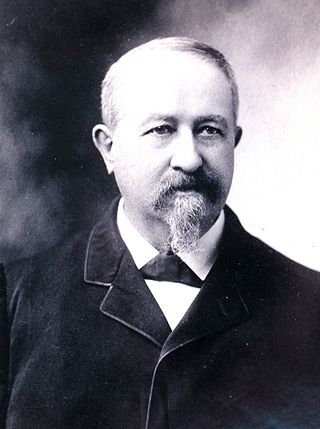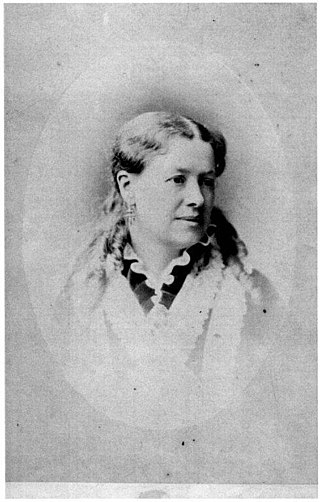
John Wesley Powell was an American geologist, U.S. Army soldier, explorer of the American West, professor at Illinois Wesleyan University, and director of major scientific and cultural institutions. He is famous for his 1869 geographic expedition, a three-month river trip down the Green and Colorado rivers, including the first official U.S. government-sponsored passage through the Grand Canyon.

Wallace Earle Stegner was an American novelist, short story writer, environmentalist, and historian, often called "The Dean of Western Writers". He won the Pulitzer Prize in 1972 and the U.S. National Book Award in 1977.

Thomas Moran was an American painter and printmaker of the Hudson River School in New York whose work often featured the Rocky Mountains. Moran and his family, wife Mary Nimmo Moran and daughter Ruth took residence in New York where he obtained work as an artist. He was a younger brother of the noted marine artist Edward Moran, with whom he shared a studio. A talented illustrator and exquisite colorist, Thomas Moran was hired as an illustrator at Scribner's Monthly. During the late 1860s, he was appointed the chief illustrator for the magazine, a position that helped him launch his career as one of the premier painters of the American landscape, in particular, the American West.

The Little Colorado River is a tributary of the Colorado River in the U.S. state of Arizona, providing the principal drainage from the Painted Desert region. Together with its major tributary, the Puerco River, it drains an area of about 26,500 square miles (69,000 km2) in eastern Arizona and western New Mexico. Although it stretches almost 340 miles (550 km), only the headwaters and the lowermost reaches flow year-round. Between St. Johns and Cameron, most of the river is a wide, braided wash, only containing water after heavy snowmelt or flash flooding.

The Dirty Devil River is an 80-mile-long (130 km) tributary of the Colorado River, located in the U.S. state of Utah. It flows through southern Utah from the confluence of the Fremont River and Muddy Creek before emptying into the Colorado River at Lake Powell.

The Powell Geographic Expedition of 1869, led by American naturalist John Wesley Powell, was the first thorough cartographic and scientific investigation of long segments of the Green and Colorado rivers in the southwestern United States, including the first recorded passage of white men through the entirety of the Grand Canyon. The expedition, which lasted approximately three months during the summer of 1869, embarked from Green River Station, Wyoming Territory and traveled downstream through parts of the present-day states of Colorado and Utah before reaching the confluence of the Colorado and Virgin rivers in present-day Arizona and Nevada. Despite a series of hardships, including losses of boats and supplies, near-drownings, and the eventual departures of several crew members, the voyage produced the first detailed descriptions of much of the previously unexplored canyon country of the Colorado Plateau.

William Henry Holmes, known as W. H. Holmes, was an American explorer, anthropologist, archaeologist, artist, scientific illustrator, cartographer, mountain climber, geologist and museum curator and director.

Clarence Edward Dutton was an American geologist and US Army officer. Dutton was born in Wallingford, Connecticut on May 15, 1841. He graduated from Yale College in 1860 and took postgraduate courses there until 1862, when he enlisted in the 21st Connecticut Volunteer Infantry; he fought at Fredericksburg, Suffolk, Nashville and Petersburg. He was elected as a member to the American Philosophical Society in 1871.

John Karl Hillers was an American government photographer.

Desolation Canyon is a remote canyon on the Green River in eastern Utah, United States that is listed on the National Register of Historic Places (NRHP). It is said to be one of the most remote areas in the contiguous United States.
Sam Adams who referred to himself as "Captain", was an early explorer of the American west, who claimed to explore the Colorado River over a number of years. He made a number of unsubstantiated claims and sought to get $20,000 from the government, which was never paid. He returned to Pennsylvania and worked as a lawyer.

Cataract Canyon is a 46-mile-long (74 km) canyon of the Colorado River located within Canyonlands National Park and Glen Canyon National Recreation Area in southern Utah. It begins at Colorado's confluence with the Green River, and its downstream terminus is the confluence with the Dirty Devil River. The lower half of the canyon is submerged beneath Lake Powell when the lake is at its normal high water elevation of 3,700 feet (1,100 m).
The Western Waters Digital Library (WWDL) provides free public access to digital collections of significant primary and secondary resources on water in the western United States. These collections have been made available by research libraries other academic and institutional partners.

Frederick Wilhelm von Egloffstein was a German-born military man, explorer, mapmaker, landscape artist and engraver. He was the first person to employ ruled glass screens, together with photography, to produce engravings.

Almon Harris Thompson, also known as A. H. Thompson, was an American topographer, geologist, explorer, educator and Civil War veteran. Often called "The Professor" or simply "Prof", Thompson is perhaps best known for being second in command of John Wesley Powell's Second Geographical Expedition (1871–1875), a federally funded scientific expedition that retraced the route of Powell's original expedition in order to further explore and map the drainages and canyons of the Green and Colorado Rivers in what is now southern Utah and northern Arizona. Thompson's diary of the expedition was originally published in the Utah Historical Quarterly in 1939. Through his work on the Powell expeditions and later as a geographer at the U.S. Geological Survey, he was responsible for naming many geographic locations in the Western United States. Thompson is also known for being a founding member of the National Geographic Society.
John F. Ross is an American historian and author. He is the recipient of the 2011 Fort Ticonderoga Award for Contributions to American History.

John Colton Sumner (1840–1907) was an American explorer who took part in the Powell Geographic Expedition of 1869. An experienced marksman and boatman, he was chosen by John Wesley Powell to lead the first boat of the expedition. He eventually had a falling out with Powell over differences in personality, and was troubled through the rest of his life over the disappearance and deaths of three other men in the expedition. His remorse and resentment became so great that, in 1902, he castrated himself.

Harriet Emma Dean Powell was a botanist and ornithologist, and the wife of John Wesley Powell. She accompanied and cared for him after the loss of his arm during the Civil War and was with him during many of his trips to explore the Western United States serving as a scientific assistant collecting samples. John Wesley Powell's personal vessel for the 1869 Powell Geographic Expedition was named the Emma Dean in her honor.

Mount Pennell is a prominent 11,413-foot elevation summit located in eastern Garfield County, Utah, United States. Mount Pennell is the second-highest mountain in the Henry Mountains, following Mount Ellen, 10.6 miles to the north. It is situated in a dry, rugged, and sparsely settled region east of Capitol Reef National Park, on primitive land administered by the Bureau of Land Management. Several deep canyons cut the sides of the mountain, which on the higher slopes supports oak, Ponderosa pine, subalpine fir, spruce, Douglas fir, and aspen. Precipitation runoff from this mountain drains into tributaries of the nearby Colorado River.

Steamboat Rock, reaching an elevation of 6,074 ft is a promontory located in the eastern Uinta Mountains, in Moffat County of northwest Colorado, United States. This iconic landmark of Dinosaur National Monument is situated at the confluence of the Green River and Yampa River. Precipitation runoff from this feature drains into the Green River. This geographical formation was originally named "Echo Rock" in John Wesley Powell's 1875 report, The Exploration of the Colorado River and Its Canyons. The Steamboat name first appeared on a 1941 United States Geological Survey map of Dinosaur National Monument. The area around it still retains the Echo Park name applied by Powell during the Powell Geographic Expedition of 1869.
 The Exploration of the Colorado River public domain audiobook at LibriVox
The Exploration of the Colorado River public domain audiobook at LibriVox 















